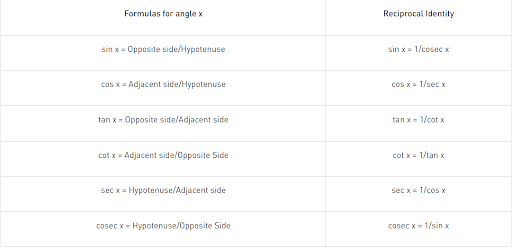If 3 cot A = 4, check whether \(\frac{(1-\text{tan}^2 A)}{(1+\text{tan}^2 A)}\) = cos2 A – sin2 A or not
Solution and Explanation
It is given that 3cot A = 4
Or, cot A =\(\frac{4}{3}\)
Consider a right triangle ABC, right-angled at point B.
cot(A) = \(\frac{AB}{BC} =\frac{ 4}{3}\)
If AB is 4k, then BC will be 3k, where k is a positive integer.
In \(Δ\)ABC,
(AC)2 = (AB)2 + (BC)2
= (4k)2 + (3k)2
= 16k2 + 9k2
= 25k2
\(⇒\) AC = 5k
tan(A) = \(\frac{BC}{AB} =\frac{ 3}{4}\)
sin (A) = \(\frac{BC}{AC} = \frac{3}{5}\)
cos (A) = \(\frac{AB}{AC} =\frac{ 4}{5}\)
\(\frac{1-tan^2A}{1+tan^2A}=\frac{1-(\frac{3}{4})^2}{1+(\frac{3}{4})^2}\)
\(=\frac{1-\frac{9}{16}}{1+\frac{9}{16}}\)
\(=\frac{7}{25}\)
cos2 A - sin2 A \(=(\frac{4}{5})^2-(\frac{3}{5})^2\)
\(=\frac{16}{25}-\frac{9}{25}\)
\(=\frac{7}{25}\)
\(∴ \frac{(1-\text{tan}^2 A)}{(1+\text{tan}^2 A)} = \text{cos}^2 A –\text{ sin }^2 A\)
Top Questions on Trigonometric Ratios
If $\tan \theta = \tfrac{3}{4}$, then the value of $\cos \theta$ will be:
- UP Board X - 2025
- Mathematics
- Trigonometric Ratios
- Evaluate \( \dfrac{2 \tan 30^\circ}{1 + \tan^2 30^\circ} \)
- AP POLYCET - 2025
- Mathematics
- Trigonometric Ratios
- If \( 15 \cot A = 8 \), then \( \sin A = \, ? \)
- AP POLYCET - 2025
- Mathematics
- Trigonometric Ratios
- Evaluate \( (\sec A + \tan A)(1 - \sin A) = \ ? \)
- AP POLYCET - 2025
- Mathematics
- Trigonometric Ratios
- Which of the following is true?
- AP POLYCET - 2025
- Mathematics
- Trigonometric Ratios
Questions Asked in CBSE X exam
- Horace ends up in prison only to regret that a man should not trust anyone blindly without finding out the truth. Do you think his own foolishness was responsible for his arrest? Give a reasoned answer.
(A Question of Trust) - Identify the error and supply the correction for the following note in an air purifier’s instruction manual.
The plug should fit upto the outlet. If it doesn’t fit, do not force it in.
Use the given format for your response. - "We have to use a planned and sustainable manner to conserve our minerals." Support the statement.
- CBSE Class X - 2025
- Minerals and Energy Resources
- Why is Matilda unhappy with her life?
- CBSE Class X - 2025
- The Necklace
आप अदिति / आदित्य हैं। आपकी दादीजी को खेलों में अत्यधिक रुचि है। ओलंपिक खेल-2024 में भारत के प्रदर्शन के बारे में जानकारी देते हुए लगभग 100 शब्दों में पत्र लिखिए।
- CBSE Class X - 2025
- पत्र लेखन
Concepts Used:
Trigonometric Functions
The relationship between the sides and angles of a right-angle triangle is described by trigonometry functions, sometimes known as circular functions. These trigonometric functions derive the relationship between the angles and sides of a triangle. In trigonometry, there are three primary functions of sine (sin), cosine (cos), tangent (tan). The other three main functions can be derived from the primary functions as cotangent (cot), secant (sec), and cosecant (cosec).
Six Basic Trigonometric Functions:
- Sine Function: The ratio between the length of the opposite side of the triangle to the length of the hypotenuse of the triangle.
sin x = a/h
- Cosine Function: The ratio between the length of the adjacent side of the triangle to the length of the hypotenuse of the triangle.
cos x = b/h
- Tangent Function: The ratio between the length of the opposite side of the triangle to the adjacent side length.
tan x = a/b
Tan x can also be represented as sin x/cos x
- Secant Function: The reciprocal of the cosine function.
sec x = 1/cosx = h/b
- Cosecant Function: The reciprocal of the sine function.
cosec x = 1/sinx = h/a
- Cotangent Function: The reciprocal of the tangent function.
cot x = 1/tan x = b/a
Formulas of Trigonometric Functions:
